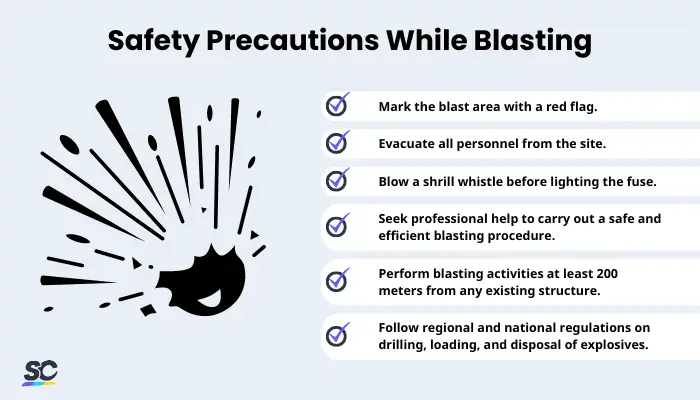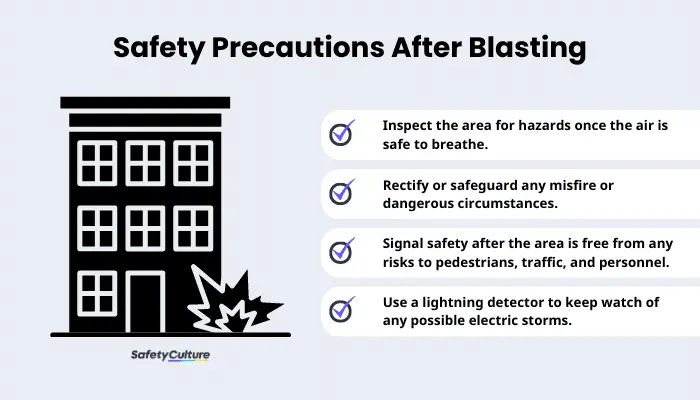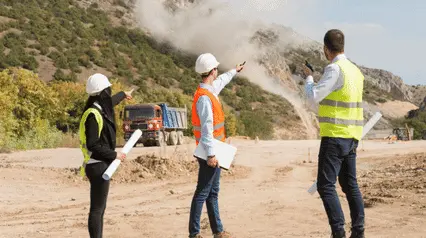What is Blasting Safety?
Working with explosives is inherently dangerous. Understanding blasting safety and putting it into practice can mean distinguishing between a successful blast and an absolute disaster. Blasting safety involves assessing, controlling, monitoring, and managing risk throughout the entire process of a blast, from site selection to clean-up. It’s essential for all members of the blasting crew to have a thorough knowledge of the dangers involved and to utilize protective gear, including glasses or face shields, hard hats, hearing protection, and flame-resistant clothing.
Safety Precautions Before Blasting
A “Blaster-in-Charge” (BIC) must oversee all the blasting operations. This person is held accountable for completing all tasks associated with these activities. Additionally, a thorough inspection of new blasting sites is necessary for hazards and environmental impacts.
Before beginning a blast, the BIC should get all blast crew personnel together to review the plans for security and emergencies in the blast area. The blast area is any place where people could get hurt from flying materials, air pressure, or gases from an explosion. The Blaster-in-Charge should discuss the following topics:
- Ensure the shot is loaded correctly, hooked up, and secured before detonating it.
- Look at the schedule to see when to set off the explosives.
- For security purposes, review the direction of the blast movement and define the blast area.
- Specify who should fire the shot and determine the safe shot initiation location.
- Review the communication system between themselves and all other blast area security personnel.
- Identify what signals to use to announce the following:
- Pre-blast warnings
- Blast time
- All clear
- Blast countdown suspension
- The implementation of general emergency plans is crucial in the case of an unexpected accident or incident.
- Evaluate methods for responding to misfires.
- Ensure that all cautionary signs have been placed and are visible.
Clearing and Guarding Procedures
BICs must coordinate with all relevant parties to ensure that all blasts are completed on time. Appropriate methods for clearing and guarding should be established and monitored regularly to guarantee successful execution.
- A safety zone should be established and secured around the shooting area, with guards assigned to every accessible entryway into the blast perimeter.
- During the clearing and guarding operation, the BIC must maintain constant radio communication with all personnel to ensure a successful mission.
- Once the security team has ensured that the area is safe and sound, the BIC should attach the primary initiation device 5 minutes before blast time.
- The next step is to sound the 5-minute warning siren.
- After 4 minutes have elapsed, the alert should notify people that they only have one minute left.
- When it’s time to detonate the explosives, the BIC must either ignite them themselves or delegate this responsibility to a shot-firer.
Safety Precautions While Blasting

Here are the key safety considerations BICs and blasting crews should consider while shooting the blast:
- A red flag will mark the blast area for everyone’s safety.
- Evacuate all personnel 200 meters from the explosives detonation site.
- Blow a shrill whistle before lighting the fuse.
- Ensure the blasting operation is carried out safely and efficiently with the help of skilled professionals.
- Unless you receive written permission from the engineer, all blasting activities must occur at least 200 meters from any existing structure.
- To ensure the safety of all personnel and surroundings, each procedure and security measure related to explosives must use: drilling before shot firing, loading after shot firing, and disposal according to regional and national regulations.
Safety Precautions After Blasting

- Once the air is safe to breathe, it’s time for the Blaster-in-Charge to inspect their work. During this inspection, they should assess the following:
- Hazardous rock conditions
- The presence of undetonated explosives or initiators
- Hazards associated with abnormal blast conditions
- Any misfire or other dangerous circumstances must be rectified or safeguarded.
- After the area is free from any risks to pedestrians, traffic, and personnel on-site, the BIC should signal safety, allowing those posted as guards to be relieved.
- A dependable lightning detector is essential to keep watch of any possible electric storms.
Precautions Against Misfire
If the blast misfires, take the following measures:
- In the event of a misfire, use an angled incision to sever the safety fuse with a knife.
- Make sure the detonator’s interior is free of sawdust.
- Blow or gently tap the open end of the detonator to remove the sawdust.
- Under no circumstance should any metal instruments be inserted into the detonator for cleaning purposes.
- If there is water in the detonator, you need to make the junction of the fuse and detonator watertight by using tough grease or other material that the engineer says is okay.
- The detonator must be put into the cartridge so that about one-third of the copper tube is showing.
- The safety fuse in the cartridge must be tied down securely so it does not move.
- Only use a waterproof fuse when there is water in the borehole or when the borehole is in a damp area.
Blast Emergency Plan
Every site should have a custom emergency plan that reflects the specific needs of that location. At a bare minimum, however, all plans should include the following:
- Make sure to post emergency telephone numbers where people can see them. It includes numbers for medical help, Occupational Safety and Health Administration (OSHA), Mine Safety and Health Administration (MSHA), the fire department, and the police. Also, have the home phone numbers of all supervisors and workers on site.
- The plan must be explained and comprehended by all personnel.
- Establish guidelines and timelines for notifications.
- Locate first-aid kits and identify personnel trained to provide medical assistance.
Create Your Own Blast Emergency Plan
Eliminate manual tasks and streamline your operations.
Get started for FREEPreparing Blast Reports
Every blast should have its report outlining the essential details. These reports must include:
- Blast date, time, and location
- Weather and environmental conditions, such as the direction and speed of the wind
- Blast geometry: including hole size(s), hole depth, drill pattern, number of holes, bench height, and sub-drilling
- Summaries of blast hole loading: typical hole loads, explosive types, primers, detonator delays, stemming type and quantity, and total explosive utilized
- Calculation of shot volume and powder factor
- Initiation timing schemes: in-hole delays, surface delays, and planned hole firing times
- Data collected during blast effect monitoring (such as ground vibration levels and air-over-pressure measurements)
- Blasting results
- BIC’s name and signature
FAQs on Blasting Safety
Blasting remains the most efficient and cost-effective technique of excavating rock for construction, quarrying, or mining operations. Structures like tunnels, bridges, and buildings use it to create open faces by breaking down large rock formations into manageable pieces. Without explosives, many projects would be unaffordable and never come to fruition.
Blasting is obliterating rocks or rock-hard soil into tiny pieces using explosives. This undertaking necessitates drilling holes, placing a detonator and explosive charge, setting off the charges, then disposing of broken material.
In blasting, up to eight boreholes can be loaded and discharged simultaneously, depending on the borehole’s size and depth. The boreholes can also be loaded and fired in any sequence. The sequence of the blast plan usually determines this.
To ensure safety, people must be at least 200 meters from the blasting site. The area should also be free of ignition sources and flammable materials. Furthermore, all personnel should wear safety equipment such as ear protection and eye protection during blasting operations.




